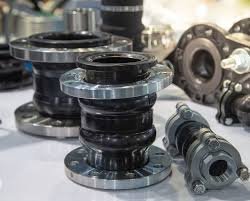What Are Flanged Expansion Joints and Why Do You Need Them?
Discover the importance of flanged expansion joints in maintaining structural integrity. Learn how they absorb movement and pressure, preventing damage to pipes, bridges, and buildings. Trust Afsjoints for high-quality, durable solutions.

What Is The Purpose Of A Flanged Expansion Joint?
A flanged expansion joint is a piping system component that absorbs vibration and reduces stress. These connectors are most commonly used for joining together pipe to pipe, pipe to fitting, and pipe to valve. Sometimes a cover place is connected a flanged joint to create a blind flange. These flanges are connected by bolting and sealing and often completed using gaskets or other methods.
What Are Features Of Flanged Expansion Joints?
• These expansion joints are designed by combining two flat annular plates that are welded together.
• The outside edges of plates are designed in one direction and the inside edges are designed in other direction
• The joint absorbs vibration, thermal expansion, and stress with minimal pressure drop.
What Are The Main Uses Of Flanged Expansion Joints?
Flanged expansion joints are generally used for serving the following purposes
• Absorb vibration: These joints absorb vibration and shock in a piping system.
• Reduce stress: They minimize stress upon the piping system.
• Compensate for misalignment: They can compensate for misalignment in a piping system.
• Minimize the noise: These expansion joints minimize noise in a piping system.
All these characteristics make flanged expansion joints as an ideal choice for industrial applications, marine applications, heating and air conditioning, power generation facilities and more.
What Types Of Movements Can A Flanged Expansion Joint Handle?
Flanged expansion joints are designed to handle axial, lateral, and angular movements. These movements are also regarded as compressive, shear, and bending deflection.
What Is Design Process For Flanged Expansion Joints?
Flanged expansion joints are composed of flat annular plates that are welded together and then attached to pipes. The design of flanged expansion joints depends upon the material used, the intended application, and the desired flexibility.
How Are Expansions Joints Inspected And Tested?
Flanged expansion joints should be inspected using a systematic approach to guarantee their longevity and functionality. Expansion joints are inspected visually for tightness and pressure. using various methods such as radiography, hydrostatic pressure tests, and magnetic particle examinations. The specific methods used depend on the application and regulatory standard. The type of test typically depends on the type of expansion joint and the factors affecting its performance.
How Are Expansion Joints Installed?
One should refer to the manufacturer's guidelines for installation, anchoring, and guides. It is recommended to look for reputed expansion joints manufacturers having expertise in providing tailored solutions.

How Are Expansion Joints Maintained?
Protecting expansion joints from weld splatter is highly recommended, and avoiding using cleaning agents that contain chloride is also recommended. One must also keep them clean, lubricated, and free of corrosion. They should also be protected from temperatures and pressures exceeding their design specifications. It are recommended to schedule regular inspection to ensure peak performance.
Flanged expansion joints are critical components used to absorb thermal expansion, vibrations, and misalignments in piping systems. A reliable expansion joint manufacturer provides a wide range of solutions tailored to various industrial applications, including multi-layered expansion joints. These multi-layered expansion joints offer enhanced durability and flexibility, effectively managing the stresses from temperature changes, pressure variations, and mechanical movement.
What's Your Reaction?














